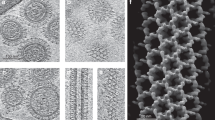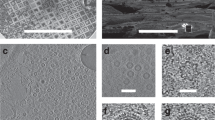Abstract
FROM studies of the growth-cycle of influenza virus, Hoyle1,2 formed the hypothesis that the virus elementary body consisted of an aggregate of smaller units, and Burnet and Lind3 arrived at a similar concept from studies of virus variation. Hoyle2,4 showed that the virus could be disintegrated by shaking with ether, with the production of separate red-cell agglutinating and complement-fixing particles of smaller size than that of the elementary body.
This is a preview of subscription content, access via your institution
Access options
Subscribe to this journal
Receive 51 print issues and online access
$199.00 per year
only $3.90 per issue
Buy this article
- Purchase on Springer Link
- Instant access to full article PDF
Prices may be subject to local taxes which are calculated during checkout
Similar content being viewed by others
References
Hoyle, L., Brit. J. Exp. Path., 29, 390 (1948).
Hoyle, L., J. Hygiene Camb., 48, 277 (1950).
Burnet, F. M., and Lind, P. E., J. Gen. Microbiol., 5, 67 (1951).
Hoyle, L., J. Hygiene Camb., 50, 229 (1952).
Author information
Authors and Affiliations
Rights and permissions
About this article
Cite this article
HOYLE, L., REED, R. & ASTBURY, W. Electron Microscope Studies of the Structure of the Influenza Virus. Nature 171, 256–257 (1953). https://doi.org/10.1038/171256b0
Issue Date:
DOI: https://doi.org/10.1038/171256b0
This article is cited by
-
How Seeing Became Knowing: The Role of the Electron Microscope in Shaping the Modern Definition of Viruses
Journal of the History of Biology (2019)
-
Die Verwendung von Influenza A2-Antigenen verschiedener Antikörperempfindlichkeit und deren ätherpräparationen zur Aufstellung von Antikörperkatastern
Zeitschrift für Hygiene und Infektionskrankheiten (1964)
-
A morphologic study of FL cells infected with para-influenza 3 virus
Archiv f�r die gesamte Virusforschung (1962)
-
Dissociation of Foot-and-Mouth Disease Virus into its Nucleic Acid and Protein Components
Nature (1961)
-
Hemagglutinin inhibition with ether-treated antigen as a more sensitive method to measure the immunological response to an asian influenza virus vaccine
Archiv f�r die gesamte Virusforschung (1961)
Comments
By submitting a comment you agree to abide by our Terms and Community Guidelines. If you find something abusive or that does not comply with our terms or guidelines please flag it as inappropriate.



